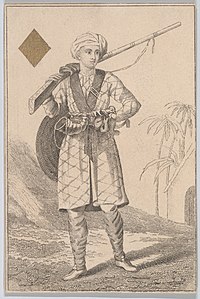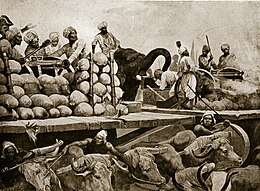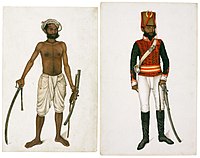Sepoy
This articleneeds additional citations forverification.(November 2020) |
| Sepoy | |
|---|---|
 Hyder Alias a sepoy | |
| Active | 16th to 21st centuries |
| Country | Mughal Empire Maratha Empire India Pakistan Nepal |
| Branch | infantry and artillery |
| Equipment | Musket |
Sepoy(/ˈsiːpɔɪ/), related tosipahi,is a term denoting professionalIndianinfantryman,traditionally armed with amusket,in thearmies of the Mughal Empireand theMaratha Army.
In the 18th century, theFrench East India Companyand its other European counterparts employed locally recruited soldiers within India, mainly consisting of infantry designated as "sepoys". The largest sepoy force, trained along European lines, served theBritish East India Company.[1][2]
The term "sipahi" or sometimes "sepoy" continues in use in the modernIndian,PakistanandNepalesearmies, where it denotes the rank ofprivate.
Etymology[edit]
In Persianاسپ(Aspa) means horse and Ispahai is also the word for cavalrymen.
The termsepoyis derived from thePersianwordsepāhī(سپاهی) meaning the traditional "infantry soldier" in theMughal Empire.
In theOttoman Empirethe termsipahiwas used to refer to cavalrymen.[3]
Historical usage[edit]
The termsepoycame into common use in the forces of the British East India Company in the eighteenth century, where it was one of a number of names, such aspeons,gentoos,mesteesandtopasses,used for various categories of native soldier. Initially it referred to Hindu or Muslim soldiers without regular uniforms or discipline. It later generically referred to all native soldiers in the service of the European powers in India.[3]Close to ninety-six percent of the British East India Company's army of 300,000 men were native to India and these sepoys played a crucial role in securing the subcontinent for the company.[4]
Equipment[edit]

The earliest sepoys usedmatchlockmuskets and operated bulky and inefficient cannons to a limited extent during the reigns ofBaburAkbarwhen archery and fighting from horseback was more common. By the time ofAurangzebthe Mughal armies had advanced significantly and utilized a wider range of weapons to win battles.
During theCarnatic WarsandAnglo-Mysore Warsthe sepoys of the Mughal Empire employed more advanced types of musket, as well asblunderbussandrocketweapons.
History[edit]
Mughal Empire 16th–18th centuries[edit]
-
AMughalsepoy, under the command ofMirza Najaf Khan.
-
TheMughal EmperorAurangzebleads his final expedition (1705), (sepoy column visible in the lower right).
ASipahior a sepoy was an infantryman armed with a musket in the army of theMughal Empire.
The earliest sepoys were armed with daggers,talwarsandmatchlocks.[5]By the mid to late 17th century they began to utilize more upgraded forms ofmusketsand evenrockets.These sepoys also operated and mountedartillerypieces and sharpshooter uponwar elephantswhich were also used for transport, hauling artillery and in combat.[6]
By the 18th century individual Nawabs employed their own sepoy units as did the European merchant companies established in parts of India.
Sepoys became more visible when they gained European arms and fought for various fragmented polities of the Mughal Empire during theCarnatic Warsand theBengal War.After which the importance of the local sepoy diminished and were replaced by the "European hired Sepoy".
Sepoys in British service[edit]
-
Kala, the Sepoy, with Saber Drawn and in Uniform. Two miniatures from theFraser Album.Delhi, 1815–1816.The David Collection
-
Sepoy of the Indian infantry, circa 1900.
-
An early 20th century sepoy in theIndian Army,wearing akurta.
TheEast India Companyinitially recruited sepoys from the local communities in theMadrasandBombay Presidencies.The emphasis here favored tall and soldierly recruits, broadly defined as being "of a proper caste and of sufficient size".[7]In the Bengal Army however, recruitment was only amongst high casteBrahminandRajputcommunities, mainly from the present dayUttar PradeshandBiharregions. Recruitment was undertaken locally by battalions or regiments often from the same community, village and even family. The commanding officer of a battalion became a form of substitute for the village chief orgaon bura.He was themai-baapor the "father and mother" of the sepoys making up thepaltan(from "platoon" ). There were many family and community ties amongst the troops and numerous instances where family members enlisted in the same battalion or regiment. Theizzat( "honour" ) of the unit was represented by theregimental colours;the new sepoy having to swear an oath in front of them on enlistment. These colours were stored in honour in thequarter guardand frequently paraded before the men. They formed a rallying point in battle. The oath of fealty by the sepoy was given to the East India Company and included a pledge of faithfulness to the salt that one has eaten.[3]
The salary of the sepoys employed by the East India Company, while not substantially greater than that paid by the rulers of Indian states, was usually paid regularly. Advances could be given and family allotments from pay due were permitted when the troops served abroad. There was acommissariatand regular rations were provided. Weapons, clothing and ammunition were provided centrally, in contrast to the soldiers of local kings whose pay was often in arrears. In addition local rulers usually expected their sepoys to arm themselves and to sustain themselves through plunder.[3]
This combination of factors led to the development of a sense of shared honour and ethos amongst the well drilled and disciplined Indian soldiery who formed the key to the success of European feats of arms in India and abroad.[3]
Following theIndian Rebellion of 1857the surviving East India Company regiments were merged into a new Indian Army under the direct control of the British Crown. The designation of "sepoy" was retained for Indian soldiers below the rank oflance naik,except in cavalry where the equivalent ranks weresowaror "trooper".
| Presidency | Salary In Rupees (1760s) |
|---|---|
| Bengal | 6[8] |
| Bombay | 7[8] |
| Madras | 7[8] |
Sepoys in French service[edit]
Following the formation of theFrench East India Company(Compagnie des Indes) in 1719, companies of Indian sepoys (cipayes) were raised to augment the French regulars and Swiss mercenary troops available. By 1720 the sepoys in French service numbered about 10,000.[9]Although much reduced in numbers after their decisive defeat in India at theBattle of Wandewashin 1760, France continued to maintain a Military Corps of Indian Sepoys (corps militaire des cipayes de l'Inde) inPondicherryuntil it was disbanded and replaced by a locally recruited gendarmerie in 1898.[10] The 19th century diplomat SirJustin Sheilcommented about the British East India Company copying the French Indian army in raising an army of Indians:
It is to the military genius of the French that we are indebted for the formation of the Indian army. Our warlike neighbours were the first to introduce into India the system of drilling native troops and converting them into a regularly disciplined force. Their example was copied by us, and the result is what we now behold.
— Sir Justin Sheil (1803–1871).[11]
Sepoys in Portuguese service[edit]
Sepoys were also recruited inPortuguese India.The termcipaio(sepoy) was also applied by the Portuguese to African soldiers inAngola,MozambiqueandPortuguese Guinea,plus African rural police officers.Cipaiosfrom Angola provided part of the garrison ofGoaduring the final years of Portuguese rule of that Indian territory.
Contemporary sepoys[edit]
The title of "sepoy" is still retained in the modernNepalese Army,Indian ArmyandPakistan Army.In each of these it designates the rank ofprivate.[12]
Other usages[edit]
The same Persian word reached English via another route in the forms ofsipahiandspahi.Zipaio,the Basque version of the word, is used byleftist Basque nationalistsas an insult for members of theBasque Police,[13]implying that they are not a national police of the Basque region due to their connection with the Spanish government.
InHispanic Americancountries, especially inArgentina,the wordcipayohas historically been used as a pejorative colloquial expression referring to individuals considered as serving foreign interests, as opposed to serving their own country.[14]
See also[edit]
- Indian Rebellion of 1857(termed by some The Sepoy Mutiny)
- Maharajah and the Sepoys
- Jawan,a contemporary soldier of the armies ofIndiaandPakistan.
- Sowar,meaning "the one who rides" in Persian, was originally a rank during the Mughal period.
- Lascar,Indian sailors in European service
- Askari,African troops in service to colonial powers similar to the Sepoys.
- Islamic Revolutionary Guard Corps,known in Persian asSepah
References[edit]
- ^Gerald Bryant (1978). "Officers of the East India Company's army in the days of Clive and Hastings".The Journal of Imperial and Commonwealth History.6(3): 203–227.doi:10.1080/03086537808582508.S2CID159458449.
- ^Presidency armies
- ^abcdeMason, Philip (1974).A Matter of Honour.London: Holt, Rhinehart & Winston.ISBN0-03-012911-7.
- ^"India's Sepoy Mutiny".Fsmitha.Retrieved24 September2013.
- ^Nicolle, David (1993).Mughul India 1504–1761.Bloomsbury USA. p.12.ISBN1-85532-344-3.
- ^Nicolle, David (1993).Mughul India 1504–1761.Bloomsbury USA. p.15.ISBN1-85532-344-3.
- ^Mason, Philip (1986).A Matter of Honour – An Account of the Indian Army, its Officers and Men.Macmillan. p. 125.ISBN0-333-41837-9.
- ^abc"Pay, Allowances and Pension"(PDF).
- ^Rene Chartrand,Louis XV's Army – Colonial and Naval Troops,ISBN1-85532-709-0
- ^Les Troupes de Marine 1622–1984,ISBN2-7025-0142-7,pp. 50–51
- ^Glimpses of Life and Manners in Persiaby Lady Mary Leonora Woulfe Sheil, with additional notes by Sir Justin Sheil[1]
- ^John Keegan,Armies of the World,ISBN0-333-17236-1,pp. 312, 545.
- ^La AN condena a dos años de cárcel al autor de los destrozos en el "bosque de Oma"[permanent dead link],Deia,12 January 2005. Quoting a sentence from theAudiencia Nacional:«siendo público y notorio que el término "zipaio"es el que se da a los miembros de la Policía» vasca.
- ^Qué significan cipayo, gorila fondos bruite y otras palabras que todos repiten y pocos conocen.Apertura





